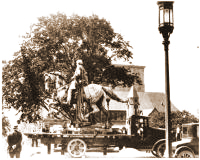Bronze MaintenanceThere are many bronze elements throughout the Capitol, which enhance both the architecture and artwork of the building, including statues, doors, and lighting fixtures. The largest and oldest bronze is an equestrian statue of General John Frederick Hartranft. Governor Hartranft was honored with this statue to commemorate his service to the Union during the Civil War and for serving two terms as governor of Pennsylvania. Standing 29 feet high, this monument was installed at the front steps of the Capitol building in May 1899. It was designed at a cost of $18,000 by noted sculptor Frederick W. Ruckstuhl. Ruckstuhl was born in Germany in 1853. When he was only a year old, his family emigrated to the United States. He studied in France at the Academie Julien under Merci, Boulanger, and Lefebvre and received honorable mention at the Paris salon in 1889. Ruckstuhl completed numerous works throughout the United States and his piece "Solon" can be seen at the Library of Congress. General Hartranft's statue remained in front of the Capitol's main entrance for twenty-eight years. In 1927, the construction of the new grand staircase required the statue to be moved to its present location in front of the Executive, Library and Museum Building (now known as the Speaker Matthew J. Ryan Building). South of the Hartranft statue is the Boise Penrose monument. Penrose's political dealings had gained him many influential friends in the House and Senate, who allotted money to create the monument in his honor. The commission agreed and the statue, sculpted by Samuel Murray, was placed in Harrisburg's South Capitol Park at the corner of Third and Walnut Streets on September 23, 1930. In addition to the bronze statues, the Capitol building is also graced with three pairs of bronze doors that were designed by Capitol architect Joseph M. Huston. Each leaf, weighing a ton, was modeled by Otto Jahnsen of J. Franklin Whitman and Company and cast by the famous Henry-Bonnard Bronze Company, both of New York City. Fabrication of the doors took fourteen months and was completed in August 1905. The main door measures 14 feet high, and the North and South doors measure 17 feet high by 9 feet wide. The Henry-Bonnard Bronze Company was one of the most reputable bronze companies in the country. It was owned by U.S. Senator W. A. Clark of Montana and was established in 1871. The bronze work executed by the firm for the Capitol was some of the finest in the nation, and was completed under the direction of bronze master Eugene F. Aucaigne. The company also cast all the railings, standards, chandeliers, bronze mailboxes and decorative grills for the Capitol post office and treasury, and the Roland Hinton Perry-designed statue "Commonwealth," which stands atop the Capitol dome. The casting of portrait heads on the main doors honored twenty individuals who were politically prominent or involved in the construction of the Capitol. From top to bottom by row, beginning with the North Leaf, they are: North Leaf Left
North Leaf Right
South Leaf Left
South Leaf Right
As part of ongoing preservation maintenance, the bronzes will undergo a yearly conservation and cleaning to help combat the effects associated with their continual exposure to the elements. |
MOVING THE HARTRANFT
APPLYING TINTED HOT WAX
APPLYING PATINA TO
WEST ENTRY BRONZE |



